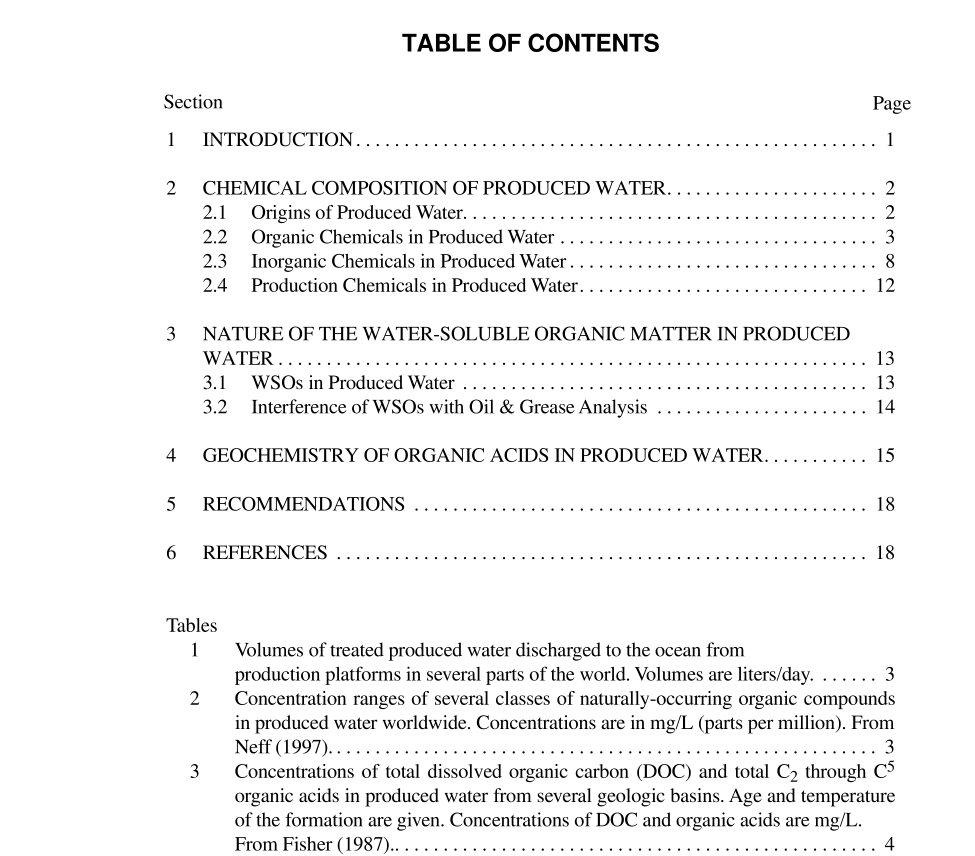API Publ 4717 pdf download

API Publ 4717 pdf download.PREDICTORS OF WATER-SOLUBLE ORGANICS (WSOs) IN PRODUCED WATER—A LITERATURE REVIEW
2 Chemical
Composition of Produced Water 2.1 ORIGINS OF PRODUCED WATER During millions of years of geologic time, petroleum and natural gas may accumulate in porous sediments (e.g., sands) trapped between layers of impermeable rock deep within the earth (Collins, 1975). Water may be trapped during millions of years with the oil and gas. This water may be derived from ancient fresh or salt water (connate water) and often is as old as the fossil fuels in the reservoir. When the hydrocarbon reservoir is tapped by a well, the produced gases and fluids may contain connate water. Also, in some oil fields, fresh or salt water may be injected into the reservoir through injection wells to displace oil toward the production wells. Sometimes, this injection water channels through to the production well and is produced with the oil and gas. The water produced with oil and gas is called produced water, produced formation water, or oilfield brine (Neff, 1987, 1997; Black et al., 1994). Before the crude oil can be refined or the gas processed, the water must be removed. During offshore operations, separation of the produced water from the oil and gas may take place on the production platform or the oil/gas/water mixture may be sent through a pipeline to a shore facility where the produced water is separated from the oil and gas. If not re-injected, the produced water is treated to meet regulatory limits for oil and grease so it may be discharged to the ocean from the platform or from an ocean outfall from a shore-based treatment facility. The current limit for total oil and grease in produced water destined for ocean disposal in U.S. Federal and Upper Cook Inlet, AK, waters is 42 mg/l (ppm) daily maximum and 29 mg/ L monthly average (Otto and Arnold, 1996; Veil, 1997).The oil/gas/water mixture may be processed through devices to separate the three phases from one another. On western Gulf of Mexico platforms, the types of equipment used to remove oil and grease from produced water include, in order of frequency of use, mechanical and hydraulic gas floatation units, skimmers, coalescers, hydrocyclones, and filters (Otto and Arnold, 1996). Chemicals may be added to the process stream to improve the efficiency of oil/gas/water separation. Even with the most advanced separation equipment, the oil/water separation is not 100% efficient. If the oil/water separation system is efficient, however, most of the chemicals remaining in the treated produced water are in solution or colloidal suspension in the water. To prevent corrosion, foaming, scale formation, hydrogen sulfide formation, and bacterial growth, or to improve the efficiency and completeness of oil/water separation, small amounts of specialty chemicals may be added to the production stream at different steps in the production and treatment process (Hudgins, 1989, 1991, 1992). Most of these chemicals remain in the oil or gas phase; others are water-soluble, remain in the produced water, and are discharged. Approximately 19% of the offshore production chemicals used on platforms in the North Sea are discharged in treated produced water, including more than 50% of the emulsifiers, surfactants, oil removing agents, and scale inhibitors (van Hattum et al., 1992; Ynnesdal and Furuholt, 1994; Hudgins, 1994). Only small amounts (less than 20% of the amounts used) of corrosion inhibitors, oxygen scavengers, emulsion breakers, defoamers, and gas treatment agents are discharged with produced water.Produced water represents the largest volume production waste stream on most offshore platforms (Stephenson, 1991). The amount of produced water discharged from a single platform usually is less than 9,400 barrels/day (bbl/d) (1.5 million liters/ day), whereas discharges from large facilities that process produced water from several platforms may exceed 25 million liters/day (Menzie, 1982). Most discharges of produced water from individual oil/water separators or production platforms to Federal waters of the western Gulf of Mexico are less than about 500 bbl/d (80,000 liters/d) (Boesch and Rabalais, 1989). The total volume of produced water discharged to US State and Federal waters of the Gulf of Mexico in 1991 was approximately 3.45 million bbl/d (549 million liters/day) (Rabalais et al., 1991) (Table 1).









